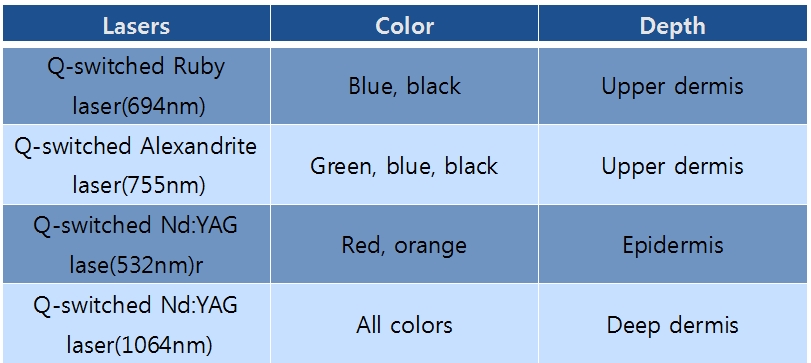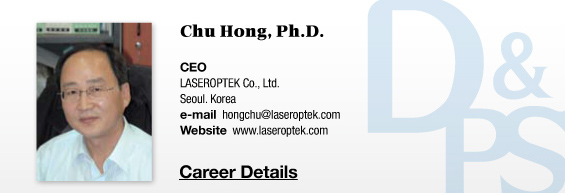7. Types and Characteristics of Lasers for Skin Treatment
7-1. Laser Types and Therapeutic Principle per Lesion
7-1-1. Laser for Pigmented Lesions
The main purpose of treating pigmented lesion is to damage pigments that are not natural or normal. There are two of these chromophores: one is melanin inside the skin, and the other is exterior dye injection. As described in the Chapter 6 (Lasers and Soft Tissue Interaction Ⅱ), for the treatment of pigmented lesion, the laser pulse width should be shorter than the thermal relaxation time (TRT) of the chromophore, for which Q-switch laser should be used. Below 3 types of lasers are currently available for the treatment of pigmented lesions by melanin inside the skin:
1) Q-switched Ruby laser (wavelength: 694nm)
Since Ruby laser has three-level energy system, the conversion efficiency of electric energy to laser output energy is low, compared to other solid-state lasers. The lasing pulse width is about 20-40ns, and lack of high repetition rate laser generationis one of the disadvantages. Not very deep penetration depth makes it difficult to treat pigmented lesions in the dermis layer.
2) Q-switched Alexandrite laser (wavelength: 755nm)
One of the merits of Alexandrite laser is in deep penetration depth than Ruby laser with pulse width of about 50-100ns at lasing, although the therapeutic effect for pigmented lesions by melanin is almost the same.
3) Q-switched Nd:YAG laser (wavelength: 1064/532nm)
Nd:YAG laser has pulse width of about 5-12ns at lasing, and is the one with the deepest penetration depth among medically used lasers. It is applicable to pigmented lesions deep in the dermis, such as nevus of Ota, and is also applicable to pigmented lesions in the epidermis because of small penetration depth at 532nm. Nd:YAG laser with the capacity of two wavelengths is most commonly used and the most effective laser for the treatment of pigmented lesions by melanin in the dermis and epidermis.
[Advertisement] HELIOSⅡ/LOTUSⅡ/HYPERION – Manufacturer: LASEROPTEK(www.laseroptek.com)
The most common type of externally injected dye is tattoo. Two things should be checked first before starting the procedure. First is to confirm the color of the dye, and the second is to see how deep the dye is located. For example, when black dye from tattoo is placed deep in the dermis, 1064nm Q-switched Nd:YAG laser is the only option, because other lasers mentioned above cannot reach the dye. In addition, injected dyes are generally made of very small grains and has very short TRT (<10-6 sec) that only Q-switched lasers can selectively damage the dye without causing injury to the surrounding normal tissues. When removing tattoo, the color and depth are generally the most important. For example, red dye reflects red color only and green dye reflects green color only, which is why we can distinguish the colors. Red tattoo would not respond at all to red wavelengths such as Ruby laser and the treatment would be futile. Below is the summary of laser type per tattoo color and depth:

Tattoos by specialists generally have various colors, making it difficult to remove the tattoo completely. Since tattoos are deep in the skin, lasers with short penetration depth cannot be used, leaving Q-switched Nd:YAG laser the only option. The treatment take a long time since Q-switched Nd:YAG laser has low absorption rate to blue, green and red colors.
7-1-2. Lasers for Vascular Lesions
Lasers for vascular lesions mostly use oxyhemoglobin as the main absorber, and removes abnormal blood vessel by selective coagulation. As mentioned above, blood vessels have long TRT and the lasers for vascular lesions generally have more than 1ms of long pulse laser and high energy fluence. Since the temperature of the upper layer increases rapidly, the upper layer should be cooled down sufficiently with Tetrafluoroethane(R-134a) or a coolant to protect it from heat injury. There are 4 lasers for selective coagulation and removal of blood vessels, and their lasing characteristics are as follows:
1) Copper vapor laser (wavelength: 578.2nm)
Copper vapor laser, also known as yellow laser, generates both 511nm green wavelength and 578.2nm yellow wavelength, with the use of copper vapor as the gain medium. Being a gas laser, it produces laser by electrical discharge. The laser has about 20nm pulse width and high repetition rate (6kHz-12kHz), making it appropriate for vascular lesions with long TRT. However, since 578nm wavelength can be also absorbed in melanin in the epidermis and dermis, post-procedural hyperpigmentation occurs frequently, especially in patients with darker skin.
2) KTP laser (wavelength: 532nm)
A 1064nm wavelength from Q-switched Nd:YAG laser incident on a nonlinear crystal called Potassium Titanium Oxide Phosphate(KTiOPO4, KTP) generates a 532nm wavelength, which is called KPT laser or frequency doubled Q-switched Nd:YAG laser. 532nm wavelength is good for the treatment of vascular lesions since it is close to the wavelength of maximum absorbance of oxyhemoglobin (542nm). The short penetration depth, however, prevents it from being used for vascular lesions in normal ways. In order to increase the penetration depth, Q-switched pulse train is generated continuously for dozens of ms, and this method is used also for the treatment of prostatic hypertrophy.
3) Pulsed dye laser (wavelength: 575-585nm)
Dye laser is a liquid laser which uses a pigment called rhodamine 6G as a gain medium. One of the characteristics of pulsed dye lasers is that they use grating to change wavelengths, ranging from 563nm to 625nm when pumped with Xe flash lamp. The therapeutic effect can be maximized by interchanging the wavelength from oxyhemoglobin’s third maximum absorption wavelength 577nm to 595nm. For example, 450us pulse width and 577nm wavelength is used for microvascular lesions, while 1.5ms pulse width at 585nm or 1.5 to 40ms pulse width at 595nm is used for larger vascular lesions which is located in deep dermal side.
4) Long pulsed Nd:YAG laser (wavelength: 1064nm)
Long pulsed Nd:YAG laser refers to a laser with variable pulse with from 0.3ms to about 300ms. This is particularly widely used for telangiectasis caused by vasodilation and vascular lesions no larger than 4mnm (especially leg veins). The benefit long pulsed Nd:YAG laser compared to the above mentioned shorter wavelength lasers, is that it is absorbed less by melanin and can penetrate deeper. In addition, since the main chromophores of blue vein, which are methemoglobin and deoxyhemoglobin, have the maximum absorption coefficient at 1064nm, it is a lot easier to treat blue veins. Adequately long pulse width allows slow and even heating of blood vessels, making them coagulated while avoiding purpura and hyperpigmentation after the laser treatment. It is still recommended to cool down the epidermis during the treatment.
7-1-3. Lasers for Resurfacing
One of the methods to treatment scars, fine wrinkles, skin tags, verrucas and dots on the skin surface is to use lasers for resurfacing. As mentioned in the Chapter 6, as about 70% of the epidermis is water, the epidermis can be selectively removed by using lasers that are well absorbed by water. There are mainly 2 types of lasers for resurfacing.
1) Er:YAG laser (wavelength: 2940nm)
This is a laser with the greatest absorption rate for water. This allows very elaborate resurfacing and the penetration depth is several um. In order to enhance thermal effect, either long pulse method that produces pulse width larger than 1ms or 300us free running method is used. Er:YAG laser is used not only for skin resurfacing but also for carving the teeth or bone in dental clinic.
2) CO2 laser (wavelength: 10600nm)
CO2 laser is a gas laser that uses 3 gases (CO2, N2 and He) supplied to and sealed in a discharge tube for lasing. The lasing uses generally 2 types; DC discharge or radio frequency (RF) discharge. The RF discharge has more stable laser output compared DC discharge and can be produced in small sizes, making it more popular than the DC discharge method. 10,600nm wavelength has great absorption rate for water, very strong thermal effect and, therefore, the effect of contracting or tighten up collagens in the dermis. However, the deeper penetration depth than Er:YAG laser raises the likelihood of hyperpigmentation.
7-1-4. Lasers for Hair Removal
Hair removal is damaging the melanin pigments by heat to prevent the hair from growing again. Each hair has different TRT depending on the thickness and generally has long TRT, which is why long pulse laser is used for hair removal. There are two types of lasers that are generally used for this purpose.
1) Laser Diode (wavelength: 810nm)
Laser diode is a semiconductor, continuous laser. Long pulse operation can be obtained by turning on/off the current input into the semiconductor laser. The wavelength of laser diode has relatively better absorption rate for melanin than 1064nm but does not allow deep penetration into the dermis, precluding complete removal of hair bulbs.
2) Long pulsed Nd:YAG laser (wavelength:1064nm)
As mentioned above, long pulsed Nd:YAG laser has relatively lower absorption rate for melanin pigments compared to that of laser diode but is most effective for hair removal because of the deep penetration depth.
- To be continued -
▶ Previous Artlcle : #4. Lasers and Soft Tissue Interaction ‖
▶ Nest Artlcle : #6. Management of Different types of Lasers





















